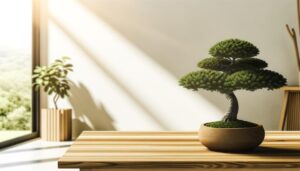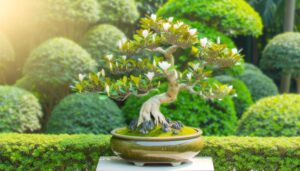Successfully Growing Japanese Maple Bonsai Indoors
Japanese Maple Bonsai can successfully be grown indoors if their specific requirements are diligently met. These trees demand 6+ hours of bright, indirect sunlight and temperatures of 60-75°F (15-24°C).
Humidity levels should be maintained at 50-75% using humidity trays or humidifiers. The soil must remain consistently moist but well-drained to prevent root rot.
Regular pruning and repotting every 2-3 years are essential for vitality. Additionally, attention to pest control and nutrient management ensures robust growth.
By carefully replicating their natural habitat, an indoor Japanese Maple Bonsai can thrive. Learn how precise interventions optimize their health and ornamental value.

Key Takeaways
- Japanese Maple Bonsai can be grown indoors if natural habitat conditions are mimicked.
- They need 6+ hours of bright, indirect sunlight daily for optimal growth.
- Maintaining humidity levels between 50-75% is crucial for indoor cultivation.
- Consistent soil moisture without waterlogging ensures healthy root systems.
- Regular pruning, balanced fertilization, and good air circulation are essential for indoor growth.
Understanding Japanese Maple Bonsai

The Japanese Maple Bonsai (Acer palmatum) is a deciduous tree known for its delicate and intricately-lobed leaves. It is a popular choice for bonsai enthusiasts due to its aesthetic appeal and manageable growth patterns.
This species exhibits seasonal foliage color changes, ranging from vibrant reds to subtle greens, enhancing its visual allure. Understanding its growth habit is vital; it typically features a shallow root system and prefers well-draining, slightly acidic soils.
Pruning is necessary for maintaining its miniature form, requiring strategic trimming to encourage desirable branch structure. Additionally, regular repotting, typically every two to three years, is needed to prevent root-bound conditions, promoting healthy growth.
Proper care secures the tree's longevity and sustains its ornamental value.
Indoor Growing Conditions
To successfully cultivate Japanese Maple Bonsai indoors, careful attention must be paid to mimicking their natural habitat, especially with regards to light, humidity, and temperature conditions.
Humidity levels should closely align with their native environment, ideally between 50-75%. Utilizing a humidity tray or a room humidifier can help achieve these levels.
Additionally, adequate air circulation is essential to prevent fungal infections and promote robust growth. Soil composition should be well-draining, consisting of a mixture of akadama, pumice, and lava rock.
Watering practices must be meticulous; the soil should remain consistently moist but not waterlogged. Employing a balanced, slow-release fertilizer will provide essential nutrients without overwhelming the plant.
Regular pruning and root trimming will maintain its miniature stature and health.
Light and Temperature Needs

Best light exposure is necessary for Japanese Maple Bonsai, requiring bright, indirect sunlight for at least six hours daily to ensure healthy photosynthesis and vibrant foliage. Inadequate light can result in weakened growth and pale leaves. Ideal temperature plays a vital role, with the recommended range being 60-75°F (15-24°C). Sudden temperature changes should be avoided to prevent stress on the plant.
| Aspect | Requirement | Impact on Plant |
|---|---|---|
| Light | Bright, indirect (6+ hrs) | Healthy photosynthesis |
| Temperature | 60-75°F (15-24°C) | Optimal growth |
| Humidity | Moderate to high | Foliage health |
| Air Circulation | Adequate | Prevents mold |
Maintaining these conditions can promote a thriving indoor Japanese Maple Bonsai, ensuring it displays its characteristic grace.
Watering and Humidity
Proper hydration and humidity control are necessary for maintaining the health and vigor of an indoor Japanese Maple Bonsai. The substrate should be kept consistently moist but never waterlogged, as excessive moisture can lead to root rot. It is advisable to use a well-draining soil mix and to water thoroughly when the top inch of soil feels dry to the touch.
Humidity levels should ideally be maintained between 50-70%, mimicking the tree's natural environment. Utilizing a humidity tray or a room humidifier can help achieve this range. Additionally, misting the foliage can provide localized humidity, though care must be taken to avoid fungal issues.
Monitoring both soil moisture and ambient humidity is essential for best growth.
Common Challenges and Solutions

Indoor cultivation of Japanese Maple Bonsai presents several challenges, including pest infestations, inadequate light exposure, and nutrient deficiencies, each requiring specific interventions to promote ideal growth.
Pest infestations, such as aphids and spider mites, can be mitigated through regular inspection and the use of insecticidal soap.
Inadequate light exposure, a common issue indoors, can be addressed by using full-spectrum grow lights to simulate natural sunlight, ensuring at least 6 hours of light daily.
Nutrient deficiencies, often manifesting as discolored leaves or stunted growth, can be resolved through the application of balanced, slow-release fertilizers tailored for bonsai.
Monitoring soil pH and ensuring proper drainage also help maintain the plant's overall health, preventing root rot and optimizing nutrient uptake.
Conclusion
Finally, cultivating Japanese Maple bonsai indoors presents a unique set of challenges and opportunities. Adhering to specific light, temperature, watering, and humidity requirements is crucial for success. Like a delicate dance, the balance of these factors guarantees the tree's health and aesthetic appeal.
By understanding and addressing common indoor growing challenges, such as inadequate light and low humidity, one can effectively nurture these miniature trees, transforming indoor spaces into lush sanctuaries.






